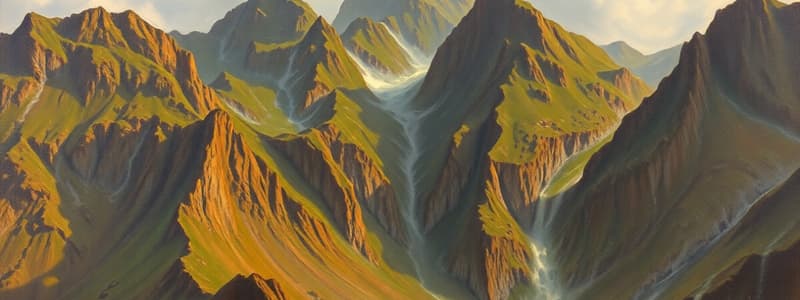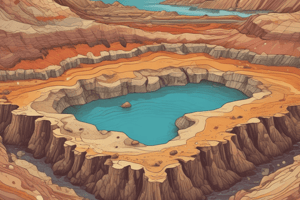Podcast
Questions and Answers
What supercontinent existed about 1.1 billion years ago before Pangaea?
What supercontinent existed about 1.1 billion years ago before Pangaea?
- Gondwanaland
- Rodinia (correct)
- Panthalassa
- Laurasia
Which sea surrounded Pangaea during the time it existed?
Which sea surrounded Pangaea during the time it existed?
- Mediterranean Sea
- Tethys Sea
- Coral Sea
- Panthalassa (correct)
What are the primary materials that compose oceanic plates?
What are the primary materials that compose oceanic plates?
- Limestone and Clay
- Basalt and Pyroxene (correct)
- Sandstone and Shale
- Granite and Quartz
Which of the following was NOT a part of Wegener's theory of continental drift?
Which of the following was NOT a part of Wegener's theory of continental drift?
Which layer of the Earth's crust is generally thicker and less dense?
Which layer of the Earth's crust is generally thicker and less dense?
Which of these plates is considered both a primary and secondary plate?
Which of these plates is considered both a primary and secondary plate?
What is the primary component of granite?
What is the primary component of granite?
What type of plate is characterized as thin and dense, primarily composed of basalt?
What type of plate is characterized as thin and dense, primarily composed of basalt?
What theory suggests that the gravitational forces pull down the lithosphere during subduction?
What theory suggests that the gravitational forces pull down the lithosphere during subduction?
Which layer of the Earth is the thinnest, making up only 1% of the Earth's volume?
Which layer of the Earth is the thinnest, making up only 1% of the Earth's volume?
Which layer of the Earth is responsible for generating its magnetic field?
Which layer of the Earth is responsible for generating its magnetic field?
What is the Mohorovicic Discontinuity known for?
What is the Mohorovicic Discontinuity known for?
Which of the following landforms is specifically created by the action of wind?
Which of the following landforms is specifically created by the action of wind?
What is the primary composition of the Earth's mantle?
What is the primary composition of the Earth's mantle?
How thick is the inner core of the Earth?
How thick is the inner core of the Earth?
What is Loess and how is it characterized?
What is Loess and how is it characterized?
What does the Raisin Theory suggest about the formation of Earth's continents?
What does the Raisin Theory suggest about the formation of Earth's continents?
What is the main premise of the Theory of Isostasy?
What is the main premise of the Theory of Isostasy?
Which scientist is known for proposing that continents may have once been a single land mass?
Which scientist is known for proposing that continents may have once been a single land mass?
How did Abraham Ortelius support his theory of continental drift?
How did Abraham Ortelius support his theory of continental drift?
What concept did Georges-Louis Leclerc contribute regarding continental fit?
What concept did Georges-Louis Leclerc contribute regarding continental fit?
What was Francois Paget's belief about the Atlantic Ocean's origin?
What was Francois Paget's belief about the Atlantic Ocean's origin?
What term describes the process affecting the structure of the Earth's crust over time?
What term describes the process affecting the structure of the Earth's crust over time?
The word 'Tecton' originally means what in Greek?
The word 'Tecton' originally means what in Greek?
What evidence supports the idea that continents were once connected?
What evidence supports the idea that continents were once connected?
Which scientist proposed that magma creates new crust through seafloor spreading?
Which scientist proposed that magma creates new crust through seafloor spreading?
What describes the process of subduction?
What describes the process of subduction?
Which type of convergent boundary involves oceanic plates subducting under continental plates?
Which type of convergent boundary involves oceanic plates subducting under continental plates?
What is a major characteristic of transform boundaries?
What is a major characteristic of transform boundaries?
What is the Wadati-Benioff zone known for?
What is the Wadati-Benioff zone known for?
Which of the following theories did Eduard Suess support?
Which of the following theories did Eduard Suess support?
Which scientist believed that heat and volcanic activity were responsible for the movement of continents?
Which scientist believed that heat and volcanic activity were responsible for the movement of continents?
What is the primary characteristic of mesas?
What is the primary characteristic of mesas?
How are buttes different from mesas?
How are buttes different from mesas?
What geological process mainly forms canyons and gorges?
What geological process mainly forms canyons and gorges?
What are the two main types of glaciers?
What are the two main types of glaciers?
What defines a V-shaped valley?
What defines a V-shaped valley?
Which statement about deltas is true?
Which statement about deltas is true?
What is a characteristic of hills compared to mountains?
What is a characteristic of hills compared to mountains?
What type of landform is characterized by steep sides and a narrow shape, and is usually formed from river or glacial erosion?
What type of landform is characterized by steep sides and a narrow shape, and is usually formed from river or glacial erosion?
Flashcards are hidden until you start studying
Study Notes
Theory of Plate Tectonics and Formation of Continents
- Raisin Theory: Earth cooled after the Big Bang, causing it to contract like a grape turning into a raisin, leading to mountain formation and ocean basins.
- Theory of Isostasy: Earth's crust floats on the mantle, achieving equilibrium between buoyancy and gravity.
- Tectonic Processes: Result in the structure and properties of the Earth's crust; referred to as tectonic plates, which are massive slabs of rock.
- Abraham Ortelius (Theatrum Orbis Terrarum): Proposed that continents were once a single landmass, evidenced by fitting coastlines.
- Georges-Louis Leclerc (Count Buffon): Supported the idea that continents like Africa and South America were once connected.
- Francois Paget: Suggested an undivided continent existed before the Atlantic Ocean was formed due to sinking during Noah’s Flood.
Wegener’s Theory of Continental Drift
- Alfred Wegener (1915): Proposed that Pangaea existed during the Permian period, with earlier supercontinent Rodinia existing about 1.1 billion years ago.
- Continental Movements: Laurasia drifted southward, colliding with Gondwanaland around 514-425 million years ago, leading to the formation of Panthalassa.
- Pangaea Splitting: During the late Triassic period, Pangaea divided into Laurasia and Gondwanaland, moving to northern and southern poles, respectively.
Evidence of Plate Movement
- Fossil Similarities: Land reptiles' fossils, such as Lystrosaurus and Cynognathus, show striking resemblances across continents.
- Snider Pellegrini: Theorized a connected continent in the Pennsylvanian Period, disrupted by the "Great Flood."
- Eduard Suess: Argued that the fern Glossopteris's seed distribution supported the theory of continental drift.
Plate Boundaries
- Seafloor Spreading Theory (Harry Hess): Describes magma from volcanic activity creating new crust, resulting in ridges on the seafloor.
- Divergent Boundaries: Plates move apart, resulting in new seafloor formation as mantle material rises.
- Convergent Boundaries: Plates collide, leading to subduction where one plate moves beneath another, creating subduction zones and Wadati-Benioff zones.
- Types of Convergent Boundaries:
- Oceanic-Continental: Oceanic subducts under continental.
- Oceanic-Oceanic: One oceanic plate subducts under another.
- Continental-Continental: Plates collide to form mountains.
- Types of Convergent Boundaries:
- Transform Boundaries: Plates slide past each other horizontally, e.g., San Andreas Fault.
- Rift Valleys: Formed at divergent boundaries through crustal extension.
Mantle Convection Theory
- Arthur Holmes (1929): Proposed that mantle movement pulls the lithosphere in a conveyor belt manner, driven by convection.
- Slab Pull Theory: Suggests that gravitational forces pull down older, denser slabs into the mantle.
Internal Structure of the Earth
- Crust: Outermost layer, about 1% of Earth, sits on the asthenosphere; Mohorovicic Discontinuity marks the boundary with the mantle.
- Mantle: Largest layer, made of molten rock, extends 2,900 km deep; divided into upper (660 km) and lower mantle.
- Outer Core: Liquid layer made of iron and nickel; responsible for Earth's magnetic field; temperature around 5,000°C.
- Inner Core: Solid, deepest layer at about 5,000°C to 6,000°C, thickness around 1,250 km.
Landforms
- Formation: Created by water, wind, ice, and tectonic forces; vary from rapid formation to millions of years.
- Types of Landforms: Mountain ranges, hills, plains, plateaus.
Aeolian Landforms
- Created by wind: Includes dunes, loess, and mushroom rocks.
- Dunes: Sand mounds; shapes include crescent or parabolic.
- Loess: Mineral-rich dust deposits.
- Mushroom Rock: Eroded rock formations.
Erosional Landforms
- Created from erosion: Includes mesas, buttes, canyons, and gorges.
- Mesas: Flat-topped mountains, surrounded by resistant rock.
- Buttes: Smaller than mesas, formed by erosion.
- Canyons/Gorges: Deep ravines carved by water or glaciers.
Mountainous and Glacial Landforms
- Volcanoes: Created through volcanic activity.
- Hills: Smaller than mountains, formed by faulting, typically under 300m tall.
- Valley/Dale: Low-lying areas formed by river or glacier actions.
- Glacial Landforms: Created by glaciers, include V-shaped (water) and U-shaped (glaciers) valleys.
Fluvial and Coastal Landforms
- Deltas: Formed where rivers meet oceans or estuaries; rich in alluvium, dating back around 7,000 years.
Studying That Suits You
Use AI to generate personalized quizzes and flashcards to suit your learning preferences.



